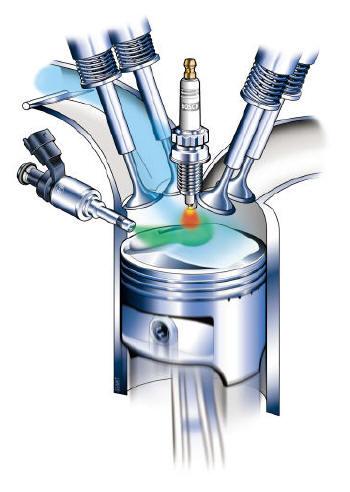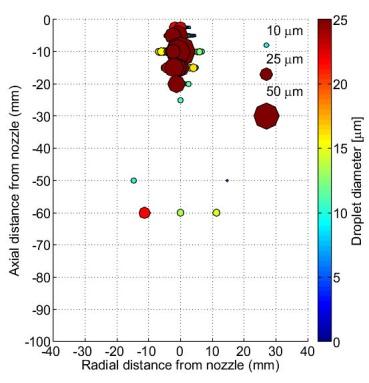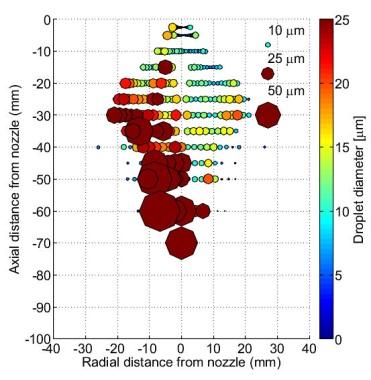4. Low-Carbon Engine Design Through Integrated Computer Simulation-Validation
Submitting Institution
Cardiff UniversityUnit of Assessment
General EngineeringSummary Impact Type
EconomicResearch Subject Area(s)
Engineering: Automotive Engineering, Mechanical Engineering, Interdisciplinary Engineering
Summary of the impact
Cardiff University's research has provided quantitative characterisation
of transient fuel sprays under engine condition for the first time. This
has enabled integrated design optimisation of Gasoline Direct injection
(GDi) engines, through computer simulation validated by Cardiff's
experimental measurements. The method has been developed and used in
collaboration with Ricardo, a world-leading engine design consultancy, and
has resulted in:
Economic impact
- Ten contracts, generating Ricardo revenue of over £20M from major OEMs
worldwide (including Ford, GM, SAIC, Proton and Chrysler);
- An additional $7M Ricardo contract secured with a major US
manufacturer (2013);
- Increased licence sales (over £1M/year sales worldwide) for commercial
software `VECTIS';
- A novel tri-fuel Spray-Guided Direct Injection (SGDI) production
engine designed and developed on behalf of PETRONAS (Malaysia).
Environmental impact
There have been substantial reductions in global CO2
emissions. Prior to 2012, GDi engine production had resulted in over 20M
tonnes CO2 reduction globally, including 10M tonnes across
Europe. A global reduction of 10M tonnes/year is predicted by 2020.
Gasoline engines designed or developed by Ricardo in collaboration with
Cardiff have provided a considerable contribution to this reduction.
Cardiff's measurement techniques provided an essential step in designing
these engines. For example, the PETRONAS engine uses 20% less fuel and
produces 80% less NOx.
Improved Professional Engineering Practice
Cardiff's experimental validation methodology has enabled Ricardo to
design engines through simulation rather than step-wise empirical
development, significantly reducing lead time.
Underpinning research
Cardiff's Innovations in Optical Diagnostics for Industrial
Applications
Cardiff's expertise in this field dates back over 30 years to the
development of bespoke laser velocimetry systems for the UK-AEA.
Subsequently, Cardiff was first to develop and publish phase-resolved
laser-Doppler anemometry for the transient fluid-dynamic
`precessing vortex core' phenomenon in industrial burners and
cyclone-separators. This research was undertaken by Syred (then Professor)
and O'Doherty (then Lecturer), between 1993-95. This resulted in the
prestigious `Combustion Institute' Sugden award for best UK paper (1997)
and a Dyson contract for characterising dust separator prototypes
(O'Doherty, 1998). Syred was Dyson's invited expert witness (1998-2000) in
their successful `Dyson versus Hoover' legal case, utilising Cardiff's
pedigree and knowledge of transient swirling flows. Cardiff also won the
`NATO award for best international Collaboration' (with Russia and
Ukraine) for its related work on gas turbines (2002).
Cardiff's Temporally-Resolved Spray Characterisation Breakthrough
Bowen (then Lecturer, 1995-97) and Bates (Reader, 1995-97) developed
Cardiff's `phase-resolved' methodology to Phase Doppler Anemometry
(PDA), enabling enlightening time-resolved characterisation, for the
first time, of 2-phase/droplet, swirling, transient flows
(e.g. sprays). Traversing this methodology over a fine grid also enhanced
the 3D spatial resolution [3.1], as shown in Figure 1. This breakthrough
found application in the automotive sector, as these are precisely the
type of flows found within automotive engine fuel sprays, where conditions
are extremely challenging, namely: millisecond injection time-scales,
1-100 micron diameter droplets, 3D swirling flows with velocity magnitudes
over 100 m/s, coupled with the extreme in-cylinder environments of high
pressures and temperatures.
Cardiff-Ricardo Research Development, Communication and Strategic
Partnership
Ricardo offers globally-leading innovation in the automotive industry.
Through an EPSRC/Ricardo funded PhD studentship (Comer 1996-99), Ricardo
sponsored Cardiff's proposition to prove and develop phase-resolved
PDA for automotive injectors, and to develop its applicability to
engine conditions. The research enabled Ricardo to validate for the first
time its transient, 3-dimensional, 2-phase commercial spray models
(within its commercial code VECTIS). Moreover, this was done under
controlled, simulated engine conditions (with high pressures and
temperatures), enabled by a new optical spray-cell which was designed and
commissioned in Cardiff's laboratories.
VECTIS is an international, industry-standard software product, focused
on in-cylinder processes in the automotive sector, which is used by
leading international engine manufacturers such as [text removed for
publication]. The Cardiff technique established confidence in the VECTIS
spray modelling, provided by like-for-like validation (rather than
time/spatial integration), hence attracting a wide range of international
clients and delivering validated spray modelling for engine
design. The technique was presented first at a British Combustion
Institute meeting (Bowen, 1997). A Cardiff-Ricardo strategic partnership
was established to consolidate this on-going research and technology
breakthrough, and facilitate the application of the phase-resolved
technique to a wide range of global automotive clients. Cardiff has
effectively industrialised the spray characterisation process to the
extent of now carrying out all of Ricardo's spray characterisation
work for use in both research and customer programmes [5.1].
Complementary to this, Brighton University undertake Ricardo's
reciprocating optical engine R&D.
A continuous sequence of five EPSRC/Ricardo funded PhD studentships at
Cardiff over the past 15 years has enabled development of the spray
characterisation methodology (see Figure 1) for: fuel injection parameter
studies [3.2]; critical analysis of optical techniques [3.3];
Computational Fluid Dynamic (CFD) model validation [3.4]; injection into
high pressures/temperatures and impingement [3.5]; and novel injector
designs involving alternative fuels. The integrated simulation/validation
methodology now routinely practiced by the Cardiff-Ricardo partnership has
proven invaluable for optimal design of GDi engines. Cardiff's pipeline of
innovative optical diagnostic techniques has continued, most recently with
another new, laser-based technique which quantifies transient in-cylinder
liquid fuel films, utilising laser-induced fluorescence principles [3.6].
(a)

(b)

(c)

Figure 1. Examples of `instantaneous' characterisation of a
Pressure-Swirl GDi Spray
(a) `Wall-Guided' GDi Operation. (b) Fuel droplet size 0.75-1.0 ms after
injection. (c) Fuel droplet size 1.75-2.0 ms after injection.
References to the research
3.1 Comer M. A., Bowen P.J., Bates C.J., Sapsford
S.M. and Johns R.J.R. (1999) Transient 3D analysis of a DI gasoline engine
injector spray, Atomisation and Sprays, Vol. 9 No. 5 pp. 467-482,
ISSN 1044-5110
3.2 Comer M.A., Bowen P.J., Sapsford S.M. and Johns,
R.J.R. (1998) The transient effects of line pressure for pressure-swirl
gasoline injectors, ILASS-EUROPE `98, Proceedings of the 14th
International Conference on Liquid Atomisation and Spray Systems, July
1998, UMIST, Manchester, pp. 364-370
3.3 Comer M.A., Bowen P.J., Bates C.J. and
Sapsford S.M. (2001) Critical appraisal of current laser diagnostic
techniques for GDi Spray kinematics quantification, Journal of Optical
Diagnostics in Engineering, Vol 5. No. 1, ISSN 1364-4173 (online
journal)
3.4 Comer M.A., Bowen P. J., Sapsford S.M. and Kwon S.I.
(2004) A parametric sensitivity study of GDI spray characteristics using a
3-D transient model, International Journal of Automotive Technology,
Vol. 5 No. 3 pp. 145-153, ISSN 1229 9138
3.5 Kay P.J., Bowen P.J., Gold M.R. and Sapsford S.M. (2012)
Transient fuel spray impingement at atmospheric and elevated ambient
conditions, Experiments in Fluids, Vol. 53 No. 4 pp. 873-890, ISSN
0723-4864, 10.1007/s00348-012-1334-0
3.6 Alonso M., Kay P.J., Bowen P.J., Gilchrist R. and Sapsford
S.M. (2010) A laser induced fluorescence technique for quantifying
transient liquid fuel films utilising total internal reflection, Experiments
in Fluids, Vol. 48 No. 1 pp. 133-142, ISSN 0732-4864 10.1007/s00348-009-0720-8
Details of the impact
The crucial importance of Cardiff's research breakthrough to the success
of the new GDi engine designs is highlighted by Ricardo's Computer Aided
Engineering (CAE) Manager James Mullineux in `Ricardo Quarterly' [5.2]: `Validating
a detailed VECTIS spray model of the selected injector is
the first step in being able to simulate the operation of a new form of
combustion system'. He continues in [5.3]: `a significant
aspect of the achievement of the T-SGDI research project has been the
ability to produce validated VECTIS models of the combustion system
that can be used to provide a truly predictive assessment of the
engine under operation. Although the approach used on the
research project included a CFD correlation exercise both with the
(Cardiff) spray rig and an optically accessed engine, the latter would, as
Mullineux concludes, not be necessary as part of a production CAE
process.' Details of the major, wide-ranging impacts achieved as a
result of the spray characterisation methodology developed at Cardiff
University are described below.
Economic impact
Significant international business has been secured for Ricardo,
the industrial sponsor and global leader in automotive engine design.
The Cardiff-Ricardo methodology has been applied and disseminated through
Ricardo and their international clients. Ricardo have, for example, used
this integrated modelling-validation methodology, in partnership with
Cardiff, to develop bespoke gasoline engine designs and fuel-injection
operational strategies on behalf of a broad range of international
clients such as [text removed for publication]. These contracts
have generated over £20M revenue for Ricardo [5.1], and
significantly more revenue for Ricardo's OEM clients through revolutionary
performance improvements and resultant sales.
Recently [5.2] the Ricardo/Cardiff partnership used its methodology in
the design of a fuel-flexible SGDI engine for Malaysian-based
multi-national PETRONAS (a Fortune 100 global
company). This engine was designed to run efficiently and flexibly on
ethanol, methanol and gasoline fuel. Hence, not only does this engine
offer the efficiency gain associated with SGDI, but also the
significant additional environmental benefit of utilising sustainable
fuels. Cardiff worked very closely with both Ricardo and
PETRONAS, including regular PETRONAS research staff visits to Cardiff's
laboratories [5.1], to ensure effective understanding and implementation
of the integrated modelling/validation approach in the engine design
process.
This SGDI engine represents a step change in direct injection (DI)
combustion system design, reaching levels of fuel consumption for diesel
engines, but without the associated costs due to throttle-free operation.
SGDI is even more dependent upon accurate temporal/spatial spray
simulation than its predecessor, the `wall guided' GDi design, thus
further emphasising the crucial role of Cardiff's methodology. PETRONAS
has recently entered into agreements with far-eastern OEMs that will
see derivatives of this engine entering volume production from 2014,
rising to in excess of 100,000 units per year [5.1].
Ricardo's commercial code VECTIS, which Cardiff's research enabled
Ricardo to validate and hence which contributes to its market lead, generates
more than £1M in revenues per annum for this innovative,
high-tech UK multi-national company. It is used by global companies such
as [text removed for publication] for combustion system design and
development.
The integrated Cardiff-Ricardo methodology has enabled the design of GDi
engines more quickly and robustly, thereby gaining significant competitive
advantage. Ricardo continues to use the integrated methodology to secure
new orders in the growing GDi market. For example, it used the
Cardiff-Ricardo methodology to secure a further $7M contract with a
major US car manufacturer in 2013 [5.1].
Environmental impact
Bosch [5.4] state that GDi engines have increased market penetration from
2% (in 2002) to 22% (in 2012). The global market for road vehicles in 2012
was around 84 million [5.5]. When coupled with downsizing and boosting
(for which DI is a major enabler), GDi technology is estimated to reduce
CO2 emissions by over 20%. Hence, interpolating data between
1996-2012 shows that GDi engine technology has already been
responsible for a reduction in new car emissions of over 20M tonnes
globally, including 10M tonnes across Europe. As Ricardo is
the leading international consultancy in GDi engine design, having
undertaken GDi design projects with many of the major global OEMs since
1996, the Cardiff-Ricardo partnership has provided a considerable
contribution to this global CO2 reduction.
Furthermore, it is projected that around 26 million cars with GDi engines
will be produced per annum by 2020 [5.4]. This represents a reduction of
CO2 emissions from new cars of over 10M tonnes per annum
(by 2020) through the adoption of GDi technology, and integration with
usage of alternative fuels will result in further CO2
savings.
Impact on engineering practice
Ricardo claim that the PETRONAS project is one of their best
examples of successful modelling-led engine designs [5.1, 5.3],
where test-bed commissioning of the first prototype performed generally as
predicted. Validated spray modelling and integrated design
(enabled by Cardiff's research) is crucial to ensuring such a successful
result [5.2] and for promotion of the elusive goal of truly simulation-led
(rather than empirical) engine design and manufacture. Ricardo state, `The
(Cardiff) fuel spray rig will always be a crucial part of the CAE tool
chain ....... As such, we have a highly efficient and cost-effective
CAE methodology that can now be applied in the development of
production implementations of this type of advanced and highly
fuel-efficient combustion technology' [5.3]. Hence, it is
clear that the Cardiff-Ricardo methodology provides additional impact
through improving professional engineering practice.
In sum, Cardiff's research has revolutionised the design of modern
gasoline engines worldwide, with global economic and environmental impacts
of major significance.
Sources to corroborate the impact
5.1 Confirmation of economic benefits and impact of Cardiff-Ricardo
partnership: Steve Sapsford, Ricardo Global Market Sector Director, (steve.sapsford@ricardo.com)
5.2 Cardiff's contribution to improved GDi engine designs : Ricardo
Quarterly (pp. 19-22), 4th Quarter, 2012 http://www.ricardo.com/PageFiles/24669/RQ_Q4_2012.pdf
5.3 Cardiff validation of VECTIS spray model critical to computer-aided
engine design:
http://www.ricardo.com/PageFiles/24138/Software_CAE_issue_2_2012.pdf
5.4 Bosch data for GDi Market Penetration. http://www.bosch-presse.de/presseforum/details.htm?txtID=6406&tk_id=108
5.5 Data enabling evaluation of CO2 reduction through GDi:
International Organization of Motor Vehicle Manufacturers (OICA) http://www.oica.net/category/production-statistics/